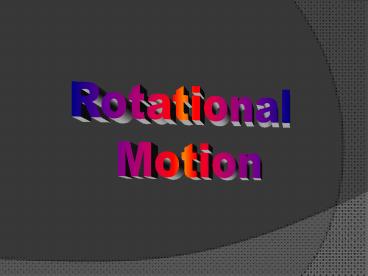Rotational Motion - PowerPoint PPT Presentation
1 / 23
Title:
Rotational Motion
Description:
Rotational motion is the spinning of an object around an axis. ... Technically, change in angular velocity divided by time calculates AVERAGE angular acceleration. ... – PowerPoint PPT presentation
Number of Views:1295
Avg rating:5.0/5.0
Title: Rotational Motion
1
Rotational Motion
2
WORKING WITH ROTATIONAL KINEMATICS
3
Rotational Motion
- Translational motion is the motion of an object
through space. - Rotational motion is the spinning of an object
around an axis. - Objects may have purely translational motion,
purely rotational motion, or both.
4
Rotational Motion
- A rigid body is composed of particles in fixed
positions. - In a rigid body undergoing purely rotational
motion, all points of the body move in circles
centered around a line called the axis of
rotation.
5
Rotational Motion
- Key to learning rotational motion
- THE CONCEPTS FROM TRANSLATIONAL MECHANICS (E.G.
VELOCITY, ACCELERATION, FORCE ENERGY, MOMENTUM)
HAVE ANALOGOUS ROTATIONAL CONCEPTS.
6
Rotational Kinematics
Angular displacement (?) is the rotational analog
of displacement (?x).
7
Rotational Kinematics
- Angular displacements are measured in radians.
- One radian (or rad) is defined as the angle
subtended by an arc length equal to one radius.
(See next slide) - Subtended
- A curve whose endpoints lie on the rays of an
angle. Equal arc lengths subtend equal angles
8
Rotational Kinematics
- ? Arc length/radius
- ? r/r 1 radian
?
For one complete revolution ? 2?r/r 2?
radians So, 2? rad 360
? 1 rad
9
Rotational Kinematics
- Answers
- 180
- ?/2
- 57.3
- 20?
- Find the following
- ? rad ___ degrees
- 90 ___ rad
- 1 rad ___ degrees
- 10 rev ___ rad
10
Rotational Kinematics
- Average angular velocity (?avg) is the rotational
analog of velocity (v). - Velocity Displacement / Time
- v ?x / t
- Ang. velocity Ang. displacement / Time
- ?avg ? / t
11
Rotational Kinematics
- The angular velocity is the same for all points
on a rigid body (Why?) - Each point on a rigid point moves through the
same angle (?) - What are the units for angular velocity?
- Degrees/time radians/s
- Why does angular displacement divided by time
calculate AVERAGE angular velocity? - (Change in angular position)/time ?avg
12
Rotational Kinematics
- What is the angular velocity of the points on a
record rotating at 45 rpm? - ? 45 rev x (2? rad / 1 rev) 90? rad
- ? ? / t
- ? 90? rad / 60 s
- ? 3?/2 rad/s
13
Rotational Kinematics
- Angular acceleration (?) is the rotational analog
of acceleration (a). - Acceleration Change in velocity / Time
- a ?v / t
- Ang. accel. Change in Ang.veloc. / Time
- ? ?? / t
14
Rotational Kinematics
- The angular acceleration is the same for all
points on a rigid body (Why?) - What are the units for angular acceleration?
- Technically, change in angular velocity divided
by time calculates AVERAGE angular acceleration.
However, we only study constant angular
accelerations.
15
Rotational Kinematics
- A record begins spinning from rest and reaches a
rotation of 45 rpm in three seconds. What is the
angular acceleration of the points on the record? - ? ?? / t
- ? (3?/2 rad/s - 0) / 3 s
- ? ?/2 rad/s2
16
Rotational Kinematics
- In translational motion, we used several
kinematics equations to analyze situations of
constant acceleration. - In rotational motion, we have equivalent
kinematics equations to analyze situations of
constant angular acceleration.
17
Rotational Kinematics
- Rotational Motion
- ? ?o ?t
- ?? (1/2)(?o ?)t
- ?avg (1/2)(?o ?)
- ? ?ot (1/2)?t2
- ?2 ?o2 2??
- Linear Motion
- v vo at
- ?x (1/2)(vo v)t
- vavg (1/2)(vo v)
- ?x vot (1/2)at2
- v2 vo2 2a?x
18
- Rotational Motion Terms
- ?z Refers to rotation about the z-axis
- This can be positive or negative (See p333)
- ?z Acceleration along z axis. Can be pos or neg
- Use Right Hand Rule to determine direction (z or
z) - See p333
19
Rotation with (non-constant) Angular
Acceleration
This graph shows the rotational ?z and az vs t
for a particular rotating body Q1 During which
time interval is the object speeding up? Q2
During which time intervals is it slowing down?
0-2, 4-6
2-4
20
Problem 1
Given ? 27.5 rad/s at t 0 a -10
rad/s2 Line PG lies on the disc
along the x -axis
- Find
- ? at t 0.30 s?
- Angle PQ makes with x axis at this time?
21
Problem 1
In addition to stated givens we know Ti 0 at t
0s
Given ? 27.5 rad/s at t 0 a -10
rad/s2 Line PG lies on the disc
along the x -axis
Part a Solution Use ?z ?iz azt
for t 0.3 s ?z (27.5 rad/s)
(-10 rad/s2)(0.3s) 24.5 rad/s
22
Part b
In addition to stated givens we know Ti 0 at t
0s
Part b Solution Use T Ti ?izt ½ azt2
for t 0.3 s T 0 (27.5
rad/s)(0.3s) ½ (-10 rad/s2)(0.3s)2 7.8 rad
revolutions? 7.8 rad (1rev/2p rad) 1.24 rev
The disc has gone through one revolution plus
0.24 into the next. So the angle at that time
with the x axis is 0.24 (360/rev) 87
23
Homework Practice
p353 Chapter 9 Do 1,3,7,8,12,14,19 READ 9.1-9.4































